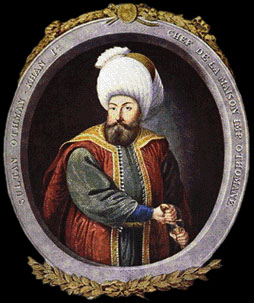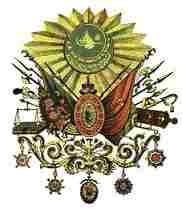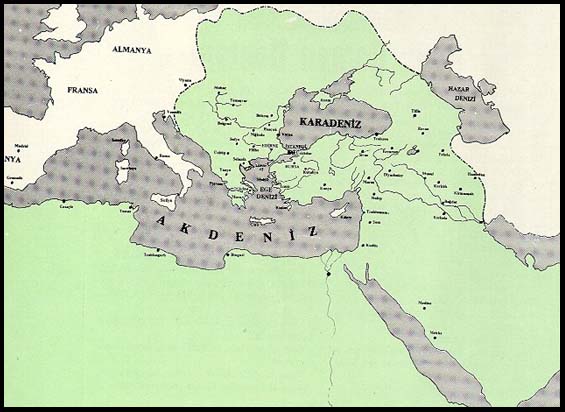 Ottoman Civilization...
Ottoman Civilization...


Following the collapse of the Seljuk State, one of several states to be established in Central Anatolia was that of the
Eretna emirate, which was founded by Eretna Bey. When Eretna Bey died in 1352, the state was left in the hands of weak
administrators and superceded by a state founded by Burhaneddin, a Kayseri judge. In the meantime, Türkmen leaders took
advantage of the political vacuum that existed to declare the establishment of their own principalities in the
13th century. Among others were the Karamanogullari in Central Anatolia, the Esrefogullari in and around
Beysehir, the Germiyanogullari in the Afyon region and the Hamidogullari in the Isparta - Burdur region.
At the beginning of the 14th century, other principalities were set up, such as the Inançogullari in the Denizli
region, the Aydinogullari in the Aydin region, the Karesiogullari in the Balikesir region, the Saruhanogullari in the
Manisa region and the Candarogullari in the Kastamonu - Çankiri - Sinop region. Oguz tribesmen of the Kayi clan had
migrated to Anatolia during the Seljuk era and it was this clan, under the leadership of Ertugrul Gazi which was to form
the nucleus of the Ottoman principality. Settling first on the Byzantine frontiers around Sögüt in the region of Bilecik
under the direction of the Seljuks. It was during the final years of the Seljuk State that they declared themselves an
independent principality known as the "Ottoman Principality", which was named after Ertugrul Bey's successor Osman Bey
(1299 - 1326). Under Orhan Bey (1326 - 1362), who was Osman Bey's successor, they captured Bursa and declared it the
Ottoman capital.
The city of Iznik is considered the cradle of Ottoman architecture and it is here that the first Ottoman mosque was built,
the Haci Özbek Mosque. This mosque, which was constructed in 1334, is notable for its single dome, a wall construction
consisting of one row of cut stone and three rows of brick along with a three - room congregation area. During the reign
of Orhan Bey, Kara Halil Hayrettin Pasha had the Yesil Cami (Green Mosque) built by architect Haci Musa in Iznik and was
completed after his death by his son, Ali Pasha in 1392, with the exterior covered with marble blocks. The materials that
went into the construction of the minaret showed the continuation of Seljuk traditions.
Ottoman architecture, which got its start in Iznik showed development which reached a monumental scale in Bursa. The mosque
that was constructed for Osman Gazi's son, Alaeddin Bey in 1326 and the Orhan Bey Mosque that was constructed in 1339 have
both been restored several times over the years. From their flashy exterior design, both the Murad Hüdavendigar Mosque and
its surrounding complex, which were built in Bursa - Cekirge, give off a palatial appearance (1385). In 1382, while he was
still the son of the sultan, Yildirim Bayezid had a complex of buildings constructed in the town of Mudurnu, which consisted
of a single - domed mosque, a school of theology and two baths. He also had the Ulu Mosque of Bergama constructed in 1398.
The grand mosque that he is truly known for is the Ulu Mosque in Bursa, which was constructed between 1396 - 1400. The
pulpit of the twenty - domed mosque is the masterpiece of Haci Mehmet bin Abdülaziz ibn el Huki, who was from Antep. The
progress of Ottoman architecture was badly shaken and even halted for awhile at the beginning of the 15th
century. It regained some liveliness when Yildirim's son Çelebi Sultan Mehmed had the architect Haci Ivaz commence with
the construction of the Yesil Cami (Green Mosque) and its surrounding complex (1424).

Subsequently, architectural planning continued to develop without a break. Construction of this mosque lasted ten years and
was built entirely from cut stone and marble. The marvelous arched gateway, external niche, the ornamentation on the frames
and windows reflect an attentive stone masonry. Subsequent to Bursa and Iznik and prior to the capture of Istanbul, the
temporary capital of Edirne symbolized the highest level of the art of the Ottoman Empire. The first monumental construction
was that of the Edirne Eski Mosque, which was started in 1403 by Emir Süleyman Celebi and completed by Celebi Sultan Mehmed
in 1414. The architecture of the mosque built with nine domes upon four heavy square pillars belonged to Haci Alaeddin of
Konya. Built by Sultan Murad II in 1436, the Edirne Muradiye Mosque was named after him and with its porcelain coating and
porcelain niche, constitutes the most important example of Turkish decorative art after the Yesil Mosque in Bursa.
In 1446, during the rule of Murat II, Yahsi Bey had the Imaret Mosque built in Tire. This mosque is important in that for
the first time ever, it utilized a half - dome design and a five - room final congregation place in its front section. As
far as architectural development was concerned, the Üç Serefeli Mosque that Murat II had built in Edirne between the years
1438 - 1447 was a truly surprising masterpiece. It was here that flying buttresses were constructed to support the dome for
the first time. Another first was applied here, with four minarets, which were twisted, hollow - grooved, diamond - shaped
and zigzagged. There were two inscriptions that bore the name of Sultan Murad and the pediments of both the courtyard
windows were made with dark blue and white colored porcelain tiles. The Mezit Bey Mosque, constructed in 1434, along with
the Darül Hadis, which was constructed in 1435, are the other major works that enriched Edirne.
After conquering Istanbul in 1453, Sultan Mehmed opened a new epoch, in which 300 mosques, eighty - five of which were domed,
fifty - seven theology schools, fifty-nine Turkish baths, twenty - nine covered markets, bridges, palaces, castles and city
walls were constructed in various cities throughout the empire. The first mosques that were constructed in Istanbul after
its conquest followed the layouts of mosques that were built in Iznik, Bursa and Edirne, but later on, a new style gradually
emerged and the half - dome became more prominent. The first application of this in Istanbul was seen with the Fatih Mosque
and its surrounding complex, which was constructed by Architect Sinaneddin Yusuf between 1462 - 1470. The complex, which
consisted of a theology school, health clinic, printing facilities, caravanserai, Turkish bath and tombs, saw its mosque
collapse in the 1765 earthquake, whereas today's existing structure with its four half - domes, was built by Sultan Mustafa
III. However, the mosque's courtyard, bottom part of the minarets and niche were remnants of the destroyed mosque.
The inscription etched in the general public gate belonged to Ali bin Safi. Sultan Mehmet the Conqueror's grandest masterpiece
was Topkapi Palace. He was succeeded by his son Sultan Bayezid II (1481 - 1512) who ordered the architect Hayrettin to construct
a complex of buildings in Edirne, which included a mosque, soup kitchen, theology school and Turkish bath between 1484 - 88.
The same sultan ordered the architect Yakup Sah bin Sultan Sah to construct another complex in Istanbul between 1501 - 1506
known as the Bayezid complex. It was here that some developments were made, including a second half - dome to the north and
an addition of a small dome on each side. Bayezid's successor was Yavuz Sultan Selim (1512 - 1520), who during his eight
years on the throne participated in major campaigns while nothing new appeared on the architecture front. In the meanwhile,
the governor of Diyarbakir, Biyikli Mehmet Pasha had the first Ottoman mosque with four half - domes built in his province
between 1516 - 1520. Yavuz Sultan Selim was not able to complete the mosque that was to be in his name. His son, Sultan
Süleyman the Magnificent completed the half - finished mosque. Ottoman art lived through its most brilliant period under
the rule of Sultan Süleyman the Magnificent (1520 - 1566). In addition to other artists of this age, it fostered a genius
by the name of Sinan the Architect and it was his splendid works of art that symbolized the power and energy of the Ottoman
Empire.
In 1522, Sinan the Architect completed the half - built Yavuz Sultan Mosque and in the same year, he also finished the Fatih
Pasa Mosque in Diyarbakir. In 1523, he built the mosque and the accompanying complex of the ex - governor to Egypt, Coban
Mustafa Pasha in Gebze, near Istanbul. It was in 1539 that Sinan the Architect constructed his first masterpiece in Istanbul,
the Haseki Complex. It was comprised of a health clinic, an elementary school, a theology school, a fountain and a soup
kitchen and while it made up a whole unit, it was built in completely separate place from the mosque. At the age of 54,
Sinan the Architect considered himself to an apprentice when he built the Sehzade Mosque between 1543 - 1548, because it
was here that he encountered the problem posed by the half - dome, though he came up with a very nice central structure
with four half - domes. Sultan Süleyman the Magnificent ordered the mosque built in memory of his beloved son, Prince
Mehmet. The Sehzade Complex, the construction of which was completed before the mosque, was made up the Tomb of Sehzade
Mehmed, a theology school, a soup kitchen and printing house.
In 1548, Sinan the Architect built a mosque and accompanying complex for the Sultan's daughter Mihrimah Sultan in Üsküdar.
Use of three half - domes was the second innovation of the mosque. In addition, the fact that there was a second final
congregation place outside and an expanded width brought us face to face with a rather different mosque. Sinan followed
this up by building an incredible complex and mosque for Sultan Süleyman the Magnificent, construction of which was
started in 1550 and completed in 1557. It was with the Süleymaniye that two half - domes were utilized in the construction
of a mosque. Along with the courtyard with a big fountain, the mosque's interior and outer appearance were considered to a
unified entity. The grand dome, which is supported in the middle by four heavy columns, is also supported on both the
entrance side and the southern direction with half - domes. Minarets are in the courtyard's four corners. The octagon -
shaped tombs of both Sultan Süleyman the Magnificent and Hürrem Sultan are situated behind the niche wall. In 1555, Sinan
the Architect built a mosque for Kaptani Derya Sinan Pasha in Besiktas. With rows constructed of cut stone and brick, he
had experimented with a different wall bonding. Sinan the Architect constructed the Vizier Kara Ahmat Pasha Complex in
Topkapi between 1554 - 58, the Molla Celebi Mosque in Findikli in 1561 and a mosque in Edirnekapi that was built between
1562 - 1565 for the daughter of Sultan Süleyman the Magnificent, Mihriman Sultan.

The domes over the courtyard portico and the final congregation room were built lower than normal giving this mosque,
which had a single minaret, a more definite appearance. In 1561, he built a mosque in Eminönü for Rüstem Pasha, who was
the Sultan's vizier and son - in - law. Sinan incorporated an eight - legged system, of which four were built into the
walls and four were left standing independently. He also decorated it with the period's Iznik porcelain tiles.
For the Sultan Süleyman's daughter, Esma Sultan, who was also the wife of the Grand Vizier Sokullu Mehmed Pasha, he
constructed the Sokullu Complex on hilly terrain in Istanbul Kadirga in the year 1571. Again, he chose to decorate the
interior of the mosque with porcelain tiles. In 1573, Sinan built the Piyale Pasha Mosque in Istanbul Kasimpasa, in
which he reverted to the style of the old Ulu Mosques by using the six equal dome layout. In 1566, Süleyman the Magnificent
was succeeded by his son Selim II (1566 - 1574), whereas Sinan constructed the Selimiye Mosque in Edirne in his name (1569
- 1575).
Sinan had reached the peak of his profession and it was at this time that he was heard to say, "I showed that I was an
apprentice with the Sehzade Mosque, an able contractor with the Süleymaniye Mosque and an expert with the Selimiye Mosque".
The towering dome and four minarets of this mosque, which took six years to built, was planted on the highest hill of Edirne
and could be seen from far. The dome's weight was supported by eight interior columns and buttressing belts that were
situated between the columns. Besides the mosque's architectural design, there were also the decorative components such
as the fine workmanship that went into the single piece stone pulpit, the porcelain decor of the window pediments and the
walls around the niche, the colorful written works found in the private galleries and the fine manner in which the portico
courtyard presented itself. Selim II died in 1574 and was succeeded to the throne by his son Murat III (1574 - 1595).
Up to then, Sinan had been in the service of four sultans, but in spite his advanced years, he went ahead and constructed
the Muradiye Mosque in Manisa between 1583 - 1585 for Sultan Murad III. He continued to wield great influence even after
his death and well into the 17th century. There were magnificent masterpieces created in this century, which
is known as the Late Classic Age. The first of these was the Yeni Mosque in Eminönü. Architect Davud Aga had laid the
foundations of this mosque and its surrounding complex for the mother of Sultan Mehmed III, Safiye Sultan in 1598. When
he died the following year from the plague, Dalgiç Ahmed took over and raised the structure up to its lower windows. When
Mehmed III died, his mother, was sent to the old palace where as construction was halted in 1603. Construction of this
mosque was finally completed in 1663, by the mother of Mehmet IV, the Queen Mother Turhan Hatice Sultan. Sultan Ahmed I
succeeded Mehmed III to the throne (1603 - 1617), who commissioned the Architect Sedefkar Mehmet Aga, who was trained by
Sinan the Architect and Davud Aga, to construct the Sultanahmet Mosque, which for all the blue porcelain tiles that
decorated its interior, was also to be known as the Blue Mosque.
There were a number of changes in the sultanate. For a time, during the reign of Ahmed III (1703 - 1730) and under the
impetus of his grand vizier Ibrahim Pasha, a period of peace ensued. In the meantime, due to its relations with France,
Ottoman architecture began to be influenced by the Baroque and Rococo styles that were popular in Europe. A thirty year
period, known as the Tulip Period, in which all eyes were turned to the West, and instead of monumental works, villas and
pavilions around Istanbul were built. However, it was about this time when construction on the Ishak Pasha Palace in Eastern
Anatolia was going on, (1685 - 1784). With Ahmed III's death, Mahmud I took the throne (1730 - 1754). It was during this
period that Baroque - style mosques were starting to be constructed. The most important of these was the Nuruosmaniye
Mosque, which was begun by Sultan Mahmud I in 1748 and completed by Sultan Osman III (1754 - 57) in 1755. There were
eleven steps that one had to walk over in order to reach the porticoed courtyard, and the interior, which was completely
covered in marble, was decorated in a highly Baroque fashion. A second work in which the Baroque style played a more
prominent role was the Laleli Mosque, in which Sultan Mustafa III (1757 - 1774) commissioned the Architect Tahir Aga.
Sultan Mustafa III's successor to the throne was Abdülhamid I, who had the Beylerbeyi Mosque built for his mother in 1778.
Selim III followed Sultan Abdülhamid I to reign the empire (1789 - 1807), whereas this sultan had a mosque built in his
name, the Selimiye Mosque in Üsküdar (1805). This mosque had continued with the Baroque style in Istanbul. Meanwhile, there
were some works under construction outside Istanbul that conveyed the same style. Leaving the 18th century and entering
the 19th century, in addition to the Baroque and Rococo styles, the Empire and Neo - classic styles were also
appearing. Around the time that the Baroque style was starting to catch on in Istanbul, the Empire style was ruling Europe,
whereas this style over to the Ottomans at practically the same time. Sultan Abdülmecid sat on the throne from 1839 - 1861
who after having the Mecidiye Villa constructed within the Topkapi Palace grounds, also commissioned to have the Dolmabahçe
Palace built, which was an exact copy of a typical European palace.
He also had both the Dolmabahçe and Ortaköy Mosques commissioned in the Empire style in honor of Bezmi Alem Valide Sultan.
Sultan Abdülaziz succeeded him to the throne (1861 - 1876) and continued with the construction activities by having both
the Beylerbeyi and Çiragan Palaces built. Handicrafts and decorative arts developed parallel to architecture in the Ottoman
Empire. Without a doubt, porcelain would be at the top of the list. Besides the most beautiful examples of Iznik porcelain
tiles that have decorated mosques and tombs in the 15th, 16th and 17th centuries, incredible
works of art, such as dishes, cups and oil lamps found in mosques. After the 17th century, the art of Iznik porcelain
was taken over by that of Kütahya.
After the acceptance of Islam by the Turkish people, branches of art that were quite restricted, such as painting and sculpture,
latched onto new interpretations, one of which was the art of miniature. The developing art of miniature, which was dependent
to the palace during the Ottoman period, brought up some major artists, such as Matrakçi Nasuh, Nakkas Osman, Nigari and Levni.
One of the branches of art that the Turkish people have always been involved with and developed is that of precious metal
workmanship. Today, the finest examples of the mineral masterpieces that we can see in the Topkapi Palace are used in special
ceremonies. These are masterpieces that reflect the splendor of the Ottomans, works such as the Topkapi Dagger, goblets,
helmets, quivers, shields and stirrups, all adorned with precious stones. Koran covers adorned with precious stones form a
separate group. In addition, there are also several fields of art that the Ottomans had taken to an advanced state,
including wood and mother - of - pearl inlaying, gilding, calligraphy, cloth and carpets.

















